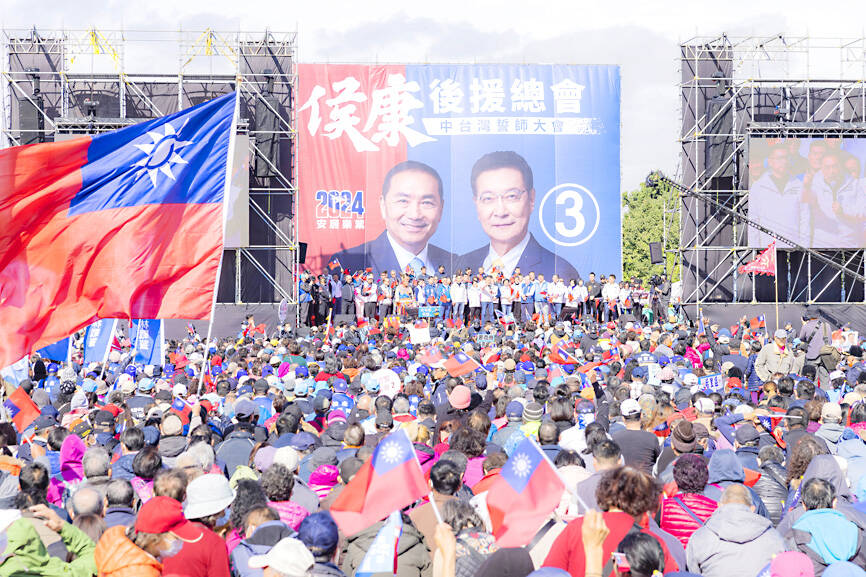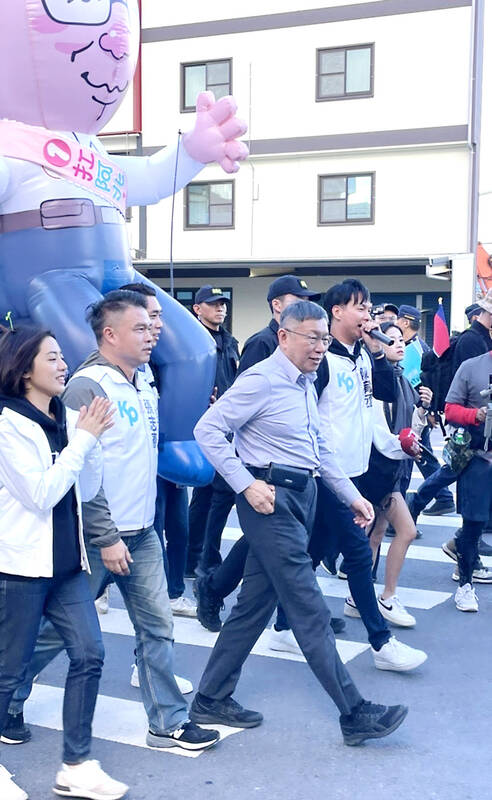Democratic Progressive Party (DPP) presidential candidate Vice President William Lai (賴清德) yesterday presented a project for the economic development of northern Taiwan, suggesting a broader subway network in Taipei and New Taipei City, and creating a “New Silicon Valley” in Taoyuan as well as Hsinchu and Miaoli counties.
The new infrastructure and construction projects could spur economic growth, attract investments and improve the living conditions of residents, Lai said.
If elected, he would push to complete the Taipei MRT Circular Line network, Lai said.

Photo: Fang Pin-chao, Taipei Times
“The Circular Line is to cover most New Taipei City districts, with Taipei at its core... When the network is completed, every district center in New Taipei City along its route would be an engine for economic growth,” Lai said.
“It was during the first DPP government that the Circular Line was proposed, and its first phase was completed in 2020.... Construction for the northern and southern sections has already started, and the designs are under way for the line’s eastern section,” he added.
Lai also proposed building a “New Danhai Science City” in New Taipei City with two districts along the coast in the north of Tamsui District (淡水) focusing on biomedical technology, healthcare and leisure while functioning as a transportation hub.

Photo courtesy of the campaign office of KMT presidential candidate Hou You-yi
Another project named the “Keelung River Valley Corridor,” would link Sijhih District (汐止) with Keelung’s Wudu (五堵) to Chidu (七堵) to set up a science and high-tech sector corridor, Lai said, adding that it would connect to the existing high-tech clusters in Taipei to boost the economic development of Taipei, New Taipei City and Keelung.
Meanwhile, the Chinese Nationalist Party (KMT) yesterday held a campaign event in Taichung’s Wurih District (烏日), which it said attracted about 60,000 people.
At the campaign rally, KMT presidential candidate New Taipei City Mayor Hou You-yi (侯友宜) pledged to extend the Taichung MRT to neighboring Changhua and Nantou counties, saying that the project had been blocked by the DPP.

Photo: Tsai Tsung-hsien, Taipei Times
Hou urged people to vote for him and the KMT to “win back the country,” as he pledged to complete the Taichung MRT extension.
Despite the DPP spending NT$2.7 billion (US$86.5 million) cracking down on scams, such cases continue to rise, Hou said, adding that if elected, in three years he would ensure fraud cases are reduced by 50 percent.
He would lead Taiwan to walk a “middle path,” in which the nation is at peace with China and friends with member of the international community, Hou said.
In contrast with the DPP and the KMT’s big rallies, Taiwan People’s Party Chairman and presidential candidate Ko Wen-je (柯文哲) yesterday accompanied a group of his supporters who had started a cross-nation walk from Taipei, as they reached Pingtung County’s Hengchun Township (恆春) yesterday.
Additional reporting by Tsai Chang-sheng, Su Meng-chuan and CNA

Chinese Nationalist Party (KMT) Chairman Eric Chu (朱立倫), spokeswoman Yang Chih-yu (楊智伃) and Legislator Hsieh Lung-chieh (謝龍介) would be summoned by police for questioning for leading an illegal assembly on Thursday evening last week, Minister of the Interior Liu Shyh-fang (劉世芳) said today. The three KMT officials led an assembly outside the Taipei City Prosecutors’ Office, a restricted area where public assembly is not allowed, protesting the questioning of several KMT staff and searches of KMT headquarters and offices in a recall petition forgery case. Chu, Yang and Hsieh are all suspected of contravening the Assembly and Parade Act (集會遊行法) by holding

PRAISE: Japanese visitor Takashi Kubota said the Taiwanese temple architecture images showcased in the AI Art Gallery were the most impressive displays he saw Taiwan does not have an official pavilion at the World Expo in Osaka, Japan, because of its diplomatic predicament, but the government-backed Tech World pavilion is drawing interest with its unique recreations of works by Taiwanese artists. The pavilion features an artificial intelligence (AI)-based art gallery showcasing works of famous Taiwanese artists from the Japanese colonial period using innovative technologies. Among its main simulated displays are Eastern gouache paintings by Chen Chin (陳進), Lin Yu-shan (林玉山) and Kuo Hsueh-hu (郭雪湖), who were the three young Taiwanese painters selected for the East Asian Painting exhibition in 1927. Gouache is a water-based

Taiwan would welcome the return of Honduras as a diplomatic ally if its next president decides to make such a move, Minister of Foreign Affairs Lin Chia-lung (林佳龍) said yesterday. “Of course, we would welcome Honduras if they want to restore diplomatic ties with Taiwan after their elections,” Lin said at a meeting of the legislature’s Foreign Affairs and National Defense Committee, when asked to comment on statements made by two of the three Honduran presidential candidates during the presidential campaign in the Central American country. Taiwan is paying close attention to the region as a whole in the wake of a

OFF-TARGET: More than 30,000 participants were expected to take part in the Games next month, but only 6,550 foreign and 19,400 Taiwanese athletes have registered Taipei city councilors yesterday blasted the organizers of next month’s World Masters Games over sudden timetable and venue changes, which they said have caused thousands of participants to back out of the international sporting event, among other organizational issues. They also cited visa delays and political interference by China as reasons many foreign athletes are requesting refunds for the event, to be held from May 17 to 30. Jointly organized by the Taipei and New Taipei City governments, the games have been rocked by numerous controversies since preparations began in 2020. Taipei City Councilor Lin Yen-feng (林延鳳) said yesterday that new measures by